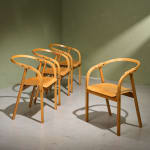-
Artworks
Werther Toffoloni & Piero Palange
back to collectionSet of 4 Demountable 'Otto' Chairs for Ibis, Italy, 1981Steam bent Beech, Beech PlywoodHeight: 73.5 cm / 28.9 in
Width: 53 cm / 20.9 in
Depth: 51 cm / 20.1 in
Seat height: 44 cm / 17.3 in
Arm height: 67 cm / 26.4 inShort lead time, ready for immediate shipping€ 3,250.00Further images
-
(View a larger image of thumbnail 1
)

-
(View a larger image of thumbnail 2
)

-
(View a larger image of thumbnail 3
)

-
(View a larger image of thumbnail 4
)

-
(View a larger image of thumbnail 5
)

-
(View a larger image of thumbnail 6
)

-
(View a larger image of thumbnail 7
)

-
(View a larger image of thumbnail 8
)

The 'Otto' Chairs were designed by Werther Toffoloni and Piero Palange in 1981 and produced by Ibis in Italy. This set of four chairs features a frame constructed from plywood,...The 'Otto' Chairs were designed by Werther Toffoloni and Piero Palange in 1981 and produced by Ibis in Italy. This set of four chairs features a frame constructed from plywood, designed for both structural efficiency and ease of use. The chairs are fully dismantlable, allowing for compact storage or transport. The frame components interlock without the need for complex hardware, reflecting a focus on practical assembly and production methods, similar to the chairs by Jean Prouvé. The seat is shaped from bent plywood, and the frame from steam bent beech forming a continuous surface that supports the body. The design follows a modular principle, using repeated elements to achieve visual and functional consistency. The Otto Chairs represent an approach to furniture making that prioritizes material use, efficient construction, and adaptability. During the early 1980s, Toffoloni and Palange explored new methods for producing modern furniture using industrial techniques, and the Otto Chair reflects that direction.
Werther Toffoloni and Piero Palange were Italian designers who collaborated on a range of furniture projects during the late 20th century. They focused on functional design, often using simple materials like plywood to create efficient, practical pieces. Their work is known for its clarity in construction and adaptability in use. Toffoloni, trained in industrial design, worked extensively in furniture and product development. Palange brought architectural insight to their designs. Together, they created pieces that reflected changing needs in modern living, emphasizing modularity, disassembly, and ease of production. Their work was part of the broader Italian design movement of the period.Condition
The chairs are sturdy and show signs of age and use throughout the legs, seating and backrest. Some restorations an fills have been performed to the frames
We have consciously chosen to photograph all of our items in their current state to present the real original condition as completely as possible for transparency towards our clients.
In case you have any additional questions about the original condition, always feel free to reach out and ask us for additional images. We do also offer services such as restoration and re-upholstery in case this is wished for. -
(View a larger image of thumbnail 1
)
Stay informed of new arrivals
* denotes required fields
We will process the personal data you have supplied in accordance with our privacy policy (available on request). You can unsubscribe or change your preferences at any time by clicking the link in our emails.








